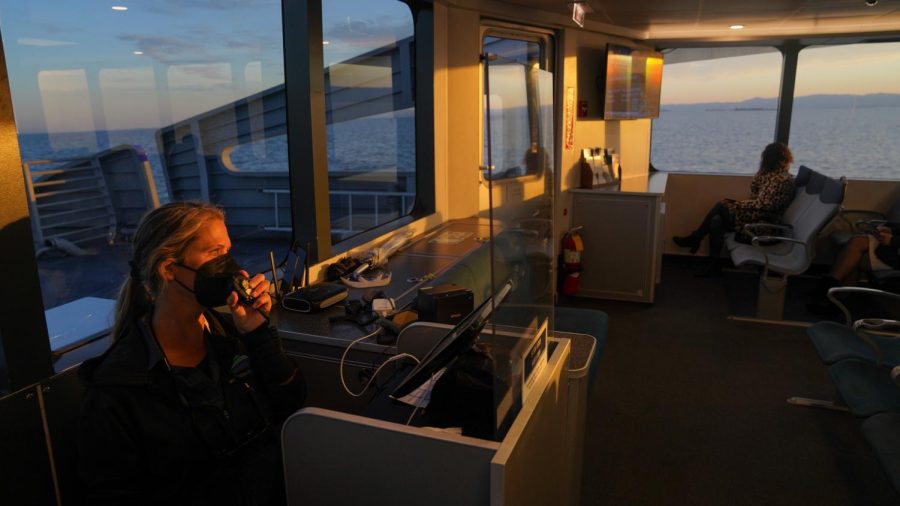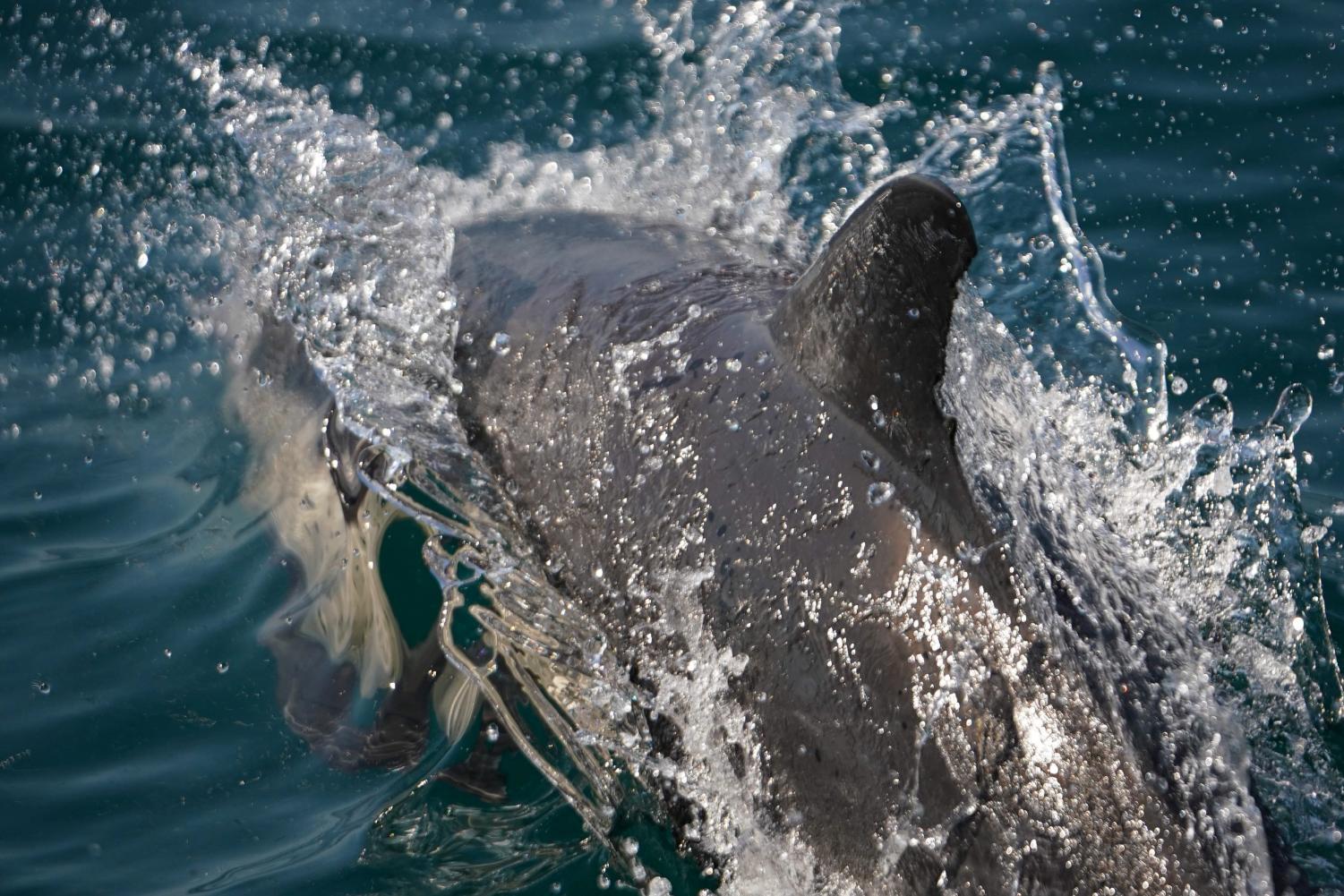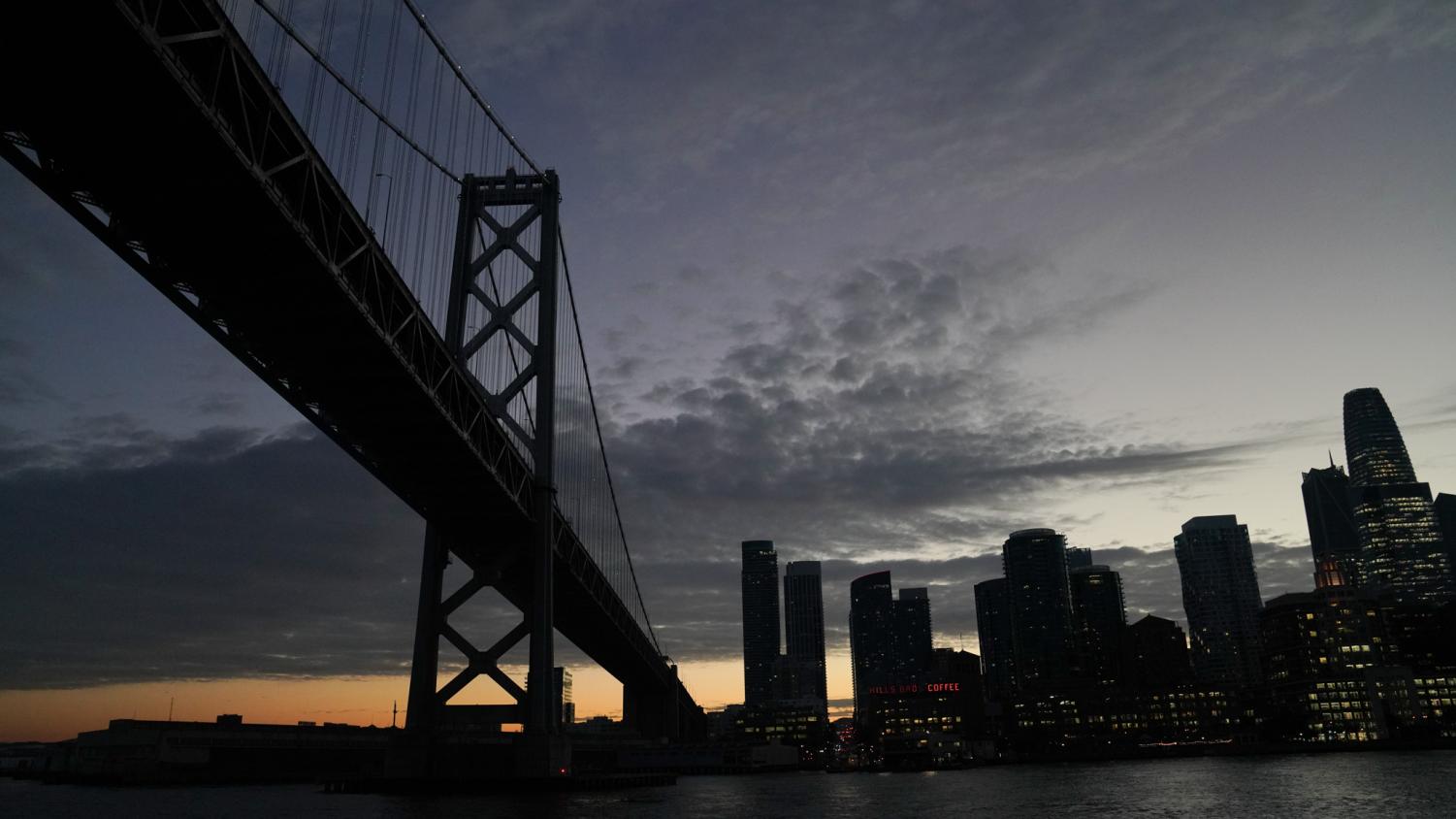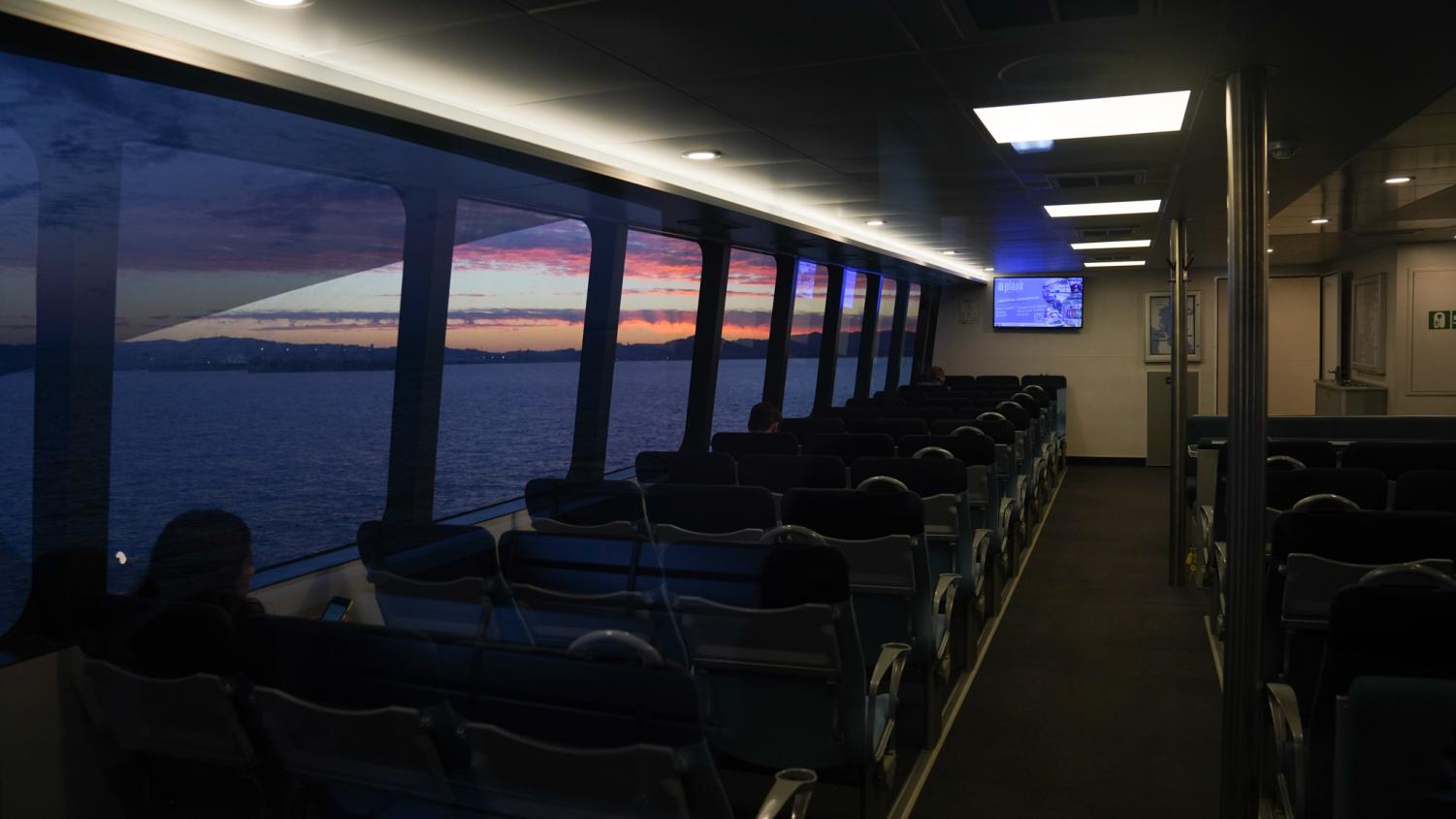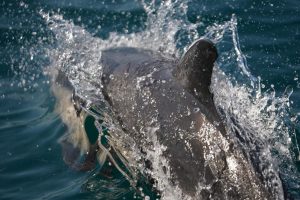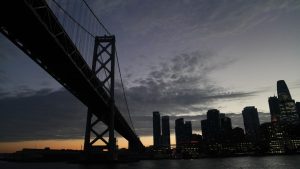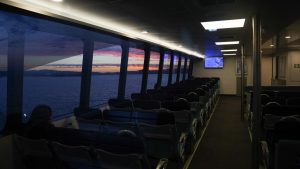Get Your Sea Legs Back
The resurgence of the ferry service for commuting and leisure in the Bay Area.
Winter Ladue makes an announcement from the Cetus ferry’s ticketing station as it transits from San Francisco to Alameda, Calif. on Nov. 14. “I like to remind everyone why they ride the ferry instead of taking BART,” Ladue said before making an announcement about the sunset. (Joshua Carter / Xpress Magazine)
At the Oakland Ferry Terminal near Jack London Square, the morning’s marine layer begins to burn off, receding back towards the peninsula. The thick, gray fog gives way to a cerulean-blue sky smudged with wispy cirrus clouds. The ebb and flow of the tide softly slaps against the pier, and the distant ring of a buoy bell fills the air. The ferry hasn’t arrived, but riders begin to gather around the gate.
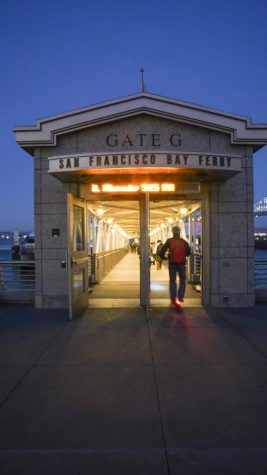
The engine’s rumble and the churning of water, accompanied by a somewhat-robotic mumble over the intercom, give the ferry’s approach away. Staff hop off the ferry, tie the vessel off and drop the ramp. Passengers make their way on board, their footsteps echoing on the thin steel ramp. Below deck, the ferry’s engine turns into a deep hum. Heaters inside offer passengers a cozy, warm relief from the brisk morning chill. The smell of old, somewhat-burnt cheap coffee permeates the room.
In the Bay Area, many locals are introduced to the public transportation system fairly early — from field trips to the Opera House on BART to ferry rides landing at Alcatraz or Angel Island. There are a variety of ways to get from one place to another in the Bay Area, many of which are taken for granted, or blur into our daily mundane routines.
But for many Bay Area residents, the ferry holds a special place in their hearts. Maybe it’s their inner pirate or free spirit, enjoying the salty air, the crash of waves against the hull and the sound of gulls squawking as they follow the wake. Maybe it’s the allure of traveling to San Francisco by water, disembarking at the water’s edge and stepping into the Embarcadero.
“It’s nice to be out on the water, especially without having to own your own boat,” said Michael Carrow, a Bay Area native who rides the ferry from Oakland to San Francisco.
Carrow and his son Owen sit on the upper back deck of the SF Bay ferry, looking out at the city as it grows in size. This time spent outdoors is much needed for the duo.
“With the pandemic and everything, it’s just nice to be outside and enjoy the fresh air…it gets tiring, being indoors so often,” said Carrow.
Carrow raises his son up to show him the full view of the Ferry Building. The clock tower, caught in a ray of morning light, dazzles in the sun.
“I used to use the ferry when I lived near Jack London Square. It was relaxing and convenient…instead of the usual bus to BART routine,” said Carrow.
Ferry service has been a part of the San Francisco Bay Area since almost its inception. With the population boom after the gold rush in 1849, a quick route between Oakland and San Francisco became necessary. The ‘Creek Route Ferry’ was one of the earliest routes established, connecting what’s now Jack London Square to San Francisco’s western waterfront.
One of the earliest ferries built primarily for trans-bay service was a 449-ton, 170-foot-long steam engine ferry called the Contra Costa. The vessel was a paddle steamer — a ship powered by a steam engine that drives a massive paddle wheel through the water. Before the propeller was invented, paddle steamers dominated the waterways.
Railroad ferries were established in the 1860s. These ferries were capable of carrying entire passenger train cars, sometimes including their locomotives. When trains arrived at Oakland via the Central Pacific Railroad line, passenger cars were loaded onto ferries and delivered to the San Francisco Belt Railroad, a line that ran parallel to the Embarcadero.
As technology advanced, ferry travel began to decline in the mid-1900s. Since then, cars have become the predominant method of travel and commuting, and driving alone to work is still California’s most used method of transportation for commuters.
Even before COVID-19, transit experienced a steady dip in riders. The pandemic and quarantine only made it worse.
The Richmond, Harbor Bay and South San Francisco ferry lines were entirely shut down and the remaining lines across the bay saw historically low numbers. After all, if a respiratory illness reaches pandemic levels, the last place most people would want to be is on a packed boat with several dozen strangers. Now, two years later, society has begun the slow transition back towards normalcy, and transit numbers have started to return to pre-pandemic levels.
As the ferry pulls up to the Embarcadero, the water churns and bubbles. The honking of cars grows louder and the sounds of the bay are replaced by those of the city. The ship raises and lowers with the tide’s flow and rubs into the rubber bumpers that line the port’s docks, making a loud squeak that echoes through the water like an eerie whale call. Deckhands rush to the ship’s side to tie off the vessel and let passengers off.
Eric Lim has been a deckhand on the trans-bay liner for a year. He throws off the last mooring line as the ship heads back towards Alameda. As he stands at the stern and stares into the wake trailing behind, the city’s skyline beams in the morning glow.
“Postcard-perfect right here,” said Lim.
During the pandemic, many people, such as Lim, felt they needed a change — a moment of clarity brought about by chaos. The pandemic forced him to reevaluate himself and the things most important to him.
“I was stressed out at my sales position, in front of the computer for eight to 10 hours,” said Lim.
Lim changed professions and became a deckhand. He enjoys how laid-back and peaceful his job is now, and likes meeting new people while testing his sea legs.
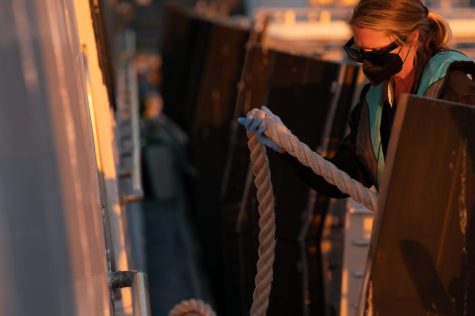
Public transit has a way of bringing people from all walks of life together.
“You meet all sorts of people on public transit, and develop a community of commuters. That you can’t do behind the steering wheel of your car,” said Thomas Hall, Public Information & Marketing Manager at the Water Emergency Transportation Authority.
Hall, who grew up in Fairfield, remembers taking the city bus as a kid to go to middle school. He’s been at the WETA for four years. The Sacramento State alumnus agrees that there is something special about the ferry.
“I’m a regular rider now and use the Vallejo line to get to work about three times a week,” said Hall.
During the pandemic, commuters from all around the Bay had to make changes to their daily routines.
With most of the population working from home, these drastic changes left once everyday commuters now out of sorts.
“We heard from a lot of people when the pandemic hit. They didn’t miss going into the office, but they did miss their commute,” recalled Hall.
It took federal aid to rescue California’s public transportation and infrastructure. Help came in the form of the American Rescue Plan Act, which provided $30.5 billion specifically for transit. The federal stimulus allowed California transit to come back from the brink of collapse and allowed ferry lines like the Harbor Bay and South San Francisco to be reinstated.
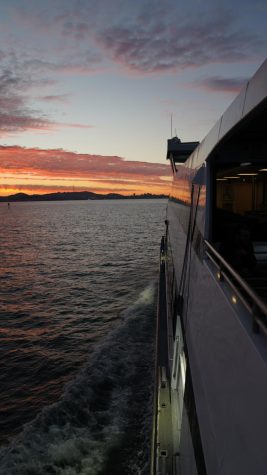
From June 2019 to June 2020, ferry service saw a systemwide drop from 302,143 riders in 2019 to 11,969 in 2020. The WETA Pandemic Recovery Plan began in July 2021, looking to not only restart suspended lines, but also enhance service by increasing midday and weekend periods to meet the demand post-quarantine. In comparison to other public transit passengers’ choice of transportation, ridership doesn’t top the Muni, BART or bus lines. However, since increasing its service schedule and departures, ridership has increased. More riders have returned to take the ferry — not solely during peak workweek commute hours, but also on recreational weekend trips.
The fresh air, beautiful views and leisurely boat ride appeal to those that have been trapped inside during quarantine for the past two years. When daily commuters take a second to pull out their phones and snap a quick photo on their way to work or back home, it becomes less about the commute and more about the journey.
“It kind of offers commuters a place to decompress and do whatever they feel like doing,” Hall explained. It gives you an opportunity to clear your mind.”


